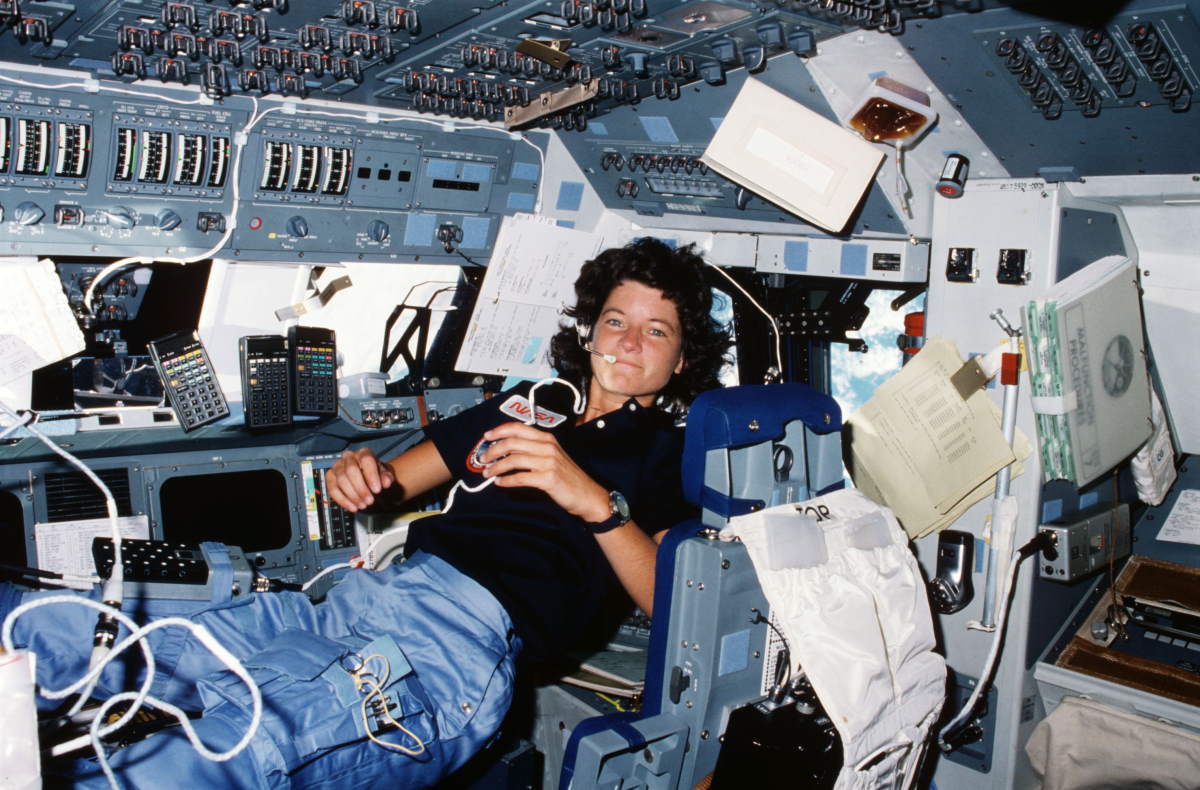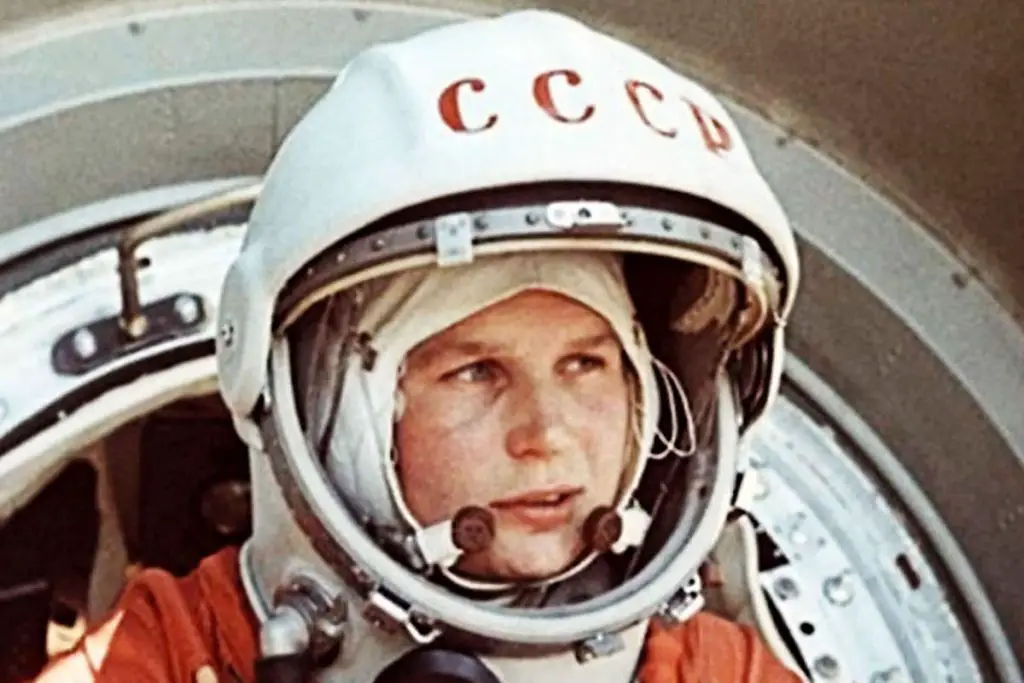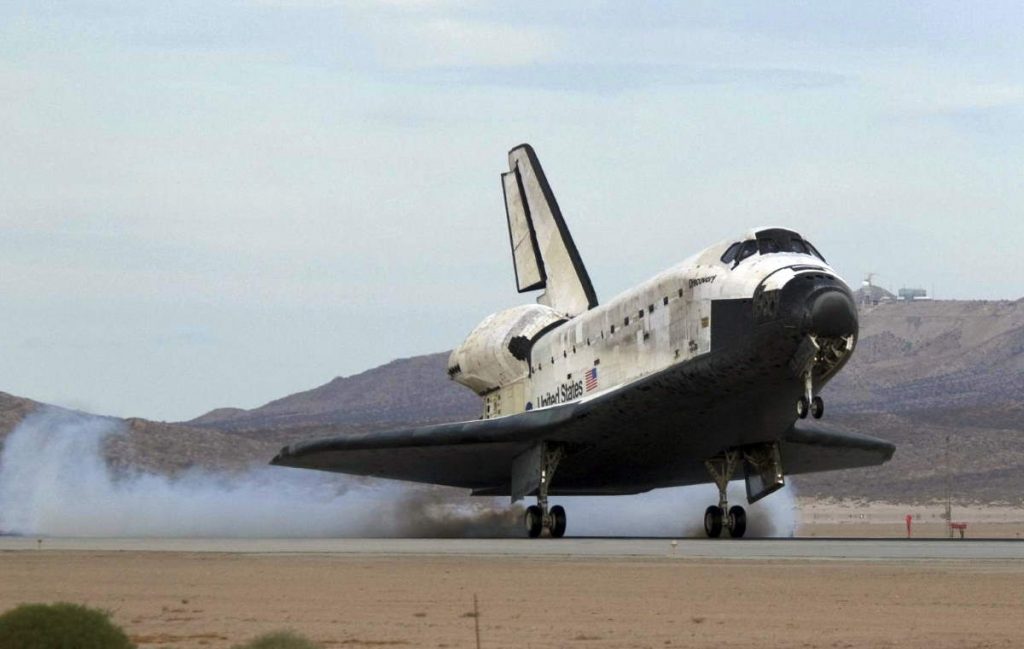On June 18, 1983, Space Shuttle Challenger and the STS-7 crew launched from NASA’s Kennedy Space Center, Florida. With the launch, one of the mission specialists, Sally Ride became the first American woman to fly in space.
STS-7 was NASA’s seventh Space Shuttle mission, and the second mission for the Space Shuttle Challenger. This mission was important in the history of space exploration, especially for three reasons:
- The first American woman in space, Sally ride was on board.
- Challenger was carrying the largest crew to fly in a single spacecraft up to that time (five people). The crew of STS-7 was:
- Commander: Robert Crippen (second spaceflight)
- Pilot: Frederick Hauck (first spaceflight)
- Mission Specialist 1: John M. Fabian (first spaceflight)
- Mission Specialist 2: Sally Ride (first spaceflight)
- Mission Specialist 3: Norman Thagard (first spaceflight)
- Commander Robert Crippen became the first astronaut to make two spaceflights aboard the Space Shuttle. He was the pilot of the Space Shuttle Columbia on STS-1 in April 1981, the first test flight of the Space Shuttle in orbit.
During the mission, Challenger deployed several satellites into orbit. The shuttle launched from Kennedy Space Center on June 18, 1983, and landed at Edwards Air Force Base on June 24, 1983.
Today’s (June 18) story of what happened this day in Science, Technology, Astronomy, and Space Exploration history.
Sally ride: the first American woman in space
For the STS-7 mission, Space Shuttle Challenger was launched on June 18, 1983. Ride later described the launch as “exhilarating, terrifying, and overwhelming all at the same time.” Although the shuttle simulators had prepared the crew well for the shaking, sound, and sights they would experience in the cockpit on liftoff, “the actual experience of a launch is not even close to the simulators!”, recalled Sally Ride.
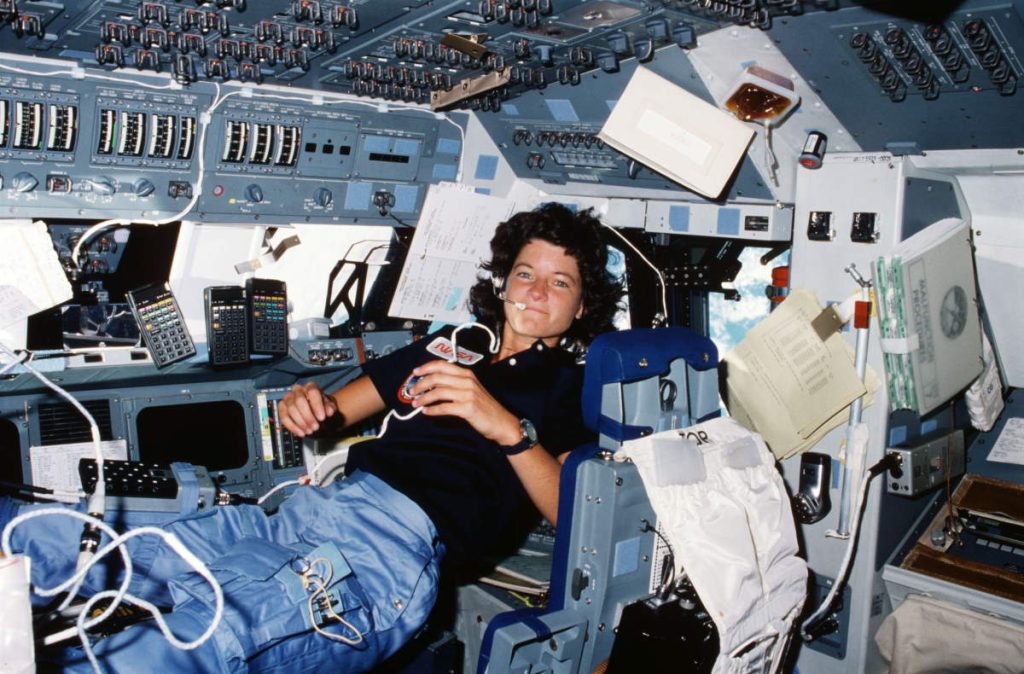
Sally Kristen Ride (May 26, 1951 – July 23, 2012) was born in Los Angeles. She started playing tennis at the age of nine, and by 1963, she was ranked number 20 in Southern California for girls aged 12 and under.
In 1970, she entered the University of California, Los Angeles. She studied Shakespeare and quantum mechanics, earning A’s in both. She was the only woman majoring in physics.
Then, she applied for a transfer to Stanford University. She earned a degree in physics.
In 1977, NASA began looking for women astronauts. No women had previously been NASA astronauts. In fact, only two women flew into space to date, and both were Soviet cosmonauts: Valentina Tereshkova, and Svetlana Yevgenyevna.
Sally Ride spotted an article on the front page of The Stanford Daily, the independent, student-run newspaper of Stanford University, that told how the National Air and Space Administration (NASA) was recruiting a new group of astronauts for the Space Shuttle program and wanted to recruit women.
She mailed a request for and received the application forms.
Ride’s application was one of 8,079 applications NASA received by the June 30, 1977 deadline. She then became one of 208 finalists. Finally, She was the only woman among the twenty applicants in the sixth group, all applicants for mission specialist positions.
Sally Ride’s fitness impressed the doctors. On January 16, 1978, she received a phone call from George Abbey, then NASA’s director of flight operations, who informed her that she had been selected as part of NASA Astronaut Group 8. She was one of 35 astronaut candidates in the group, of whom six were women.
Before flying into space, She served as a ground-based Capsule Communicator (CapCom) for the second and third Space Shuttle flights (STS-2 and STS-3) and became the first female CapCom.
For the STS-7 mission, NASA Headquarters ultimately chose Ride as the woman astronaut to fly on the mission. The decision was officially announced in April 1982. Sally Ride’s agreeable personality, ability to work with others, her performance as CapCom, and her skill with the robot arm played a major role in this decision.

Do you weep when things go wrong?
Sally Ride would be the first female American to fly into space, so she received a lot of media attention. During NASA’s usual pre-launch press conference on May 24, 1983, she was asked questions such as, “Will the flight affect your reproductive organs?” and “Do you weep when things go wrong on the job?”
Even NASA employees were adjusting to female astronauts. Engineers had asked Ride to assist them in developing a “space makeup kit”. They also infamously suggested providing Ride with a supply of 100 tampons for the six-day mission.
STS-7 Mission
Sally Ride became the first American woman to fly in space when the Space Shuttle Challenger lifted off from the Kennedy Space Center (KSC) on June 18, 1983. She also became the youngest American astronaut in space.
Later, she recalled the launch as “exhilarating, terrifying, and overwhelming all at the same time”.
She said: “The simulators just don’t capture the psychological and emotional feelings that come along with the actual launch. Those are fueled by the realization that you’re not in the simulator, you’re sitting on top of tons of rocket fuel and it’s basically exploding underneath you. It’s an emotionally and psychologically overwhelming experience. Very exhilarating. Exhilarating, terrifying, and overwhelming all at the same time”.
The six-day mission was the most complex in the shuttle program to date.
The deployment and capture of SPAS-01 (Shuttle pallet satellite) was a key objective of the mission because it demonstrated the Shuttle’s capabilities to work with another orbiting body close to the Shuttle. Sally Ride used the Shuttle RMS to remove SPAS-01 from the cargo bay and release it into orbit.
Sally Ride recalled: “The act of releasing a satellite and then backing the arm away felt very much like it did in the simulators. But the act of going up and capturing a satellite was a little scarier. I remember thinking, ‘Oh, my gosh. This is a real metal that will hit real metal if I miss. What if we don’t capture this satellite? It was easy in the simulators, but is it going to be as easy in orbit?’ It turned out that it was, but the experience was different because it was real.”
The camera mounted on SPAS-1 took amazing pictures of the orbiter (see the picture below).
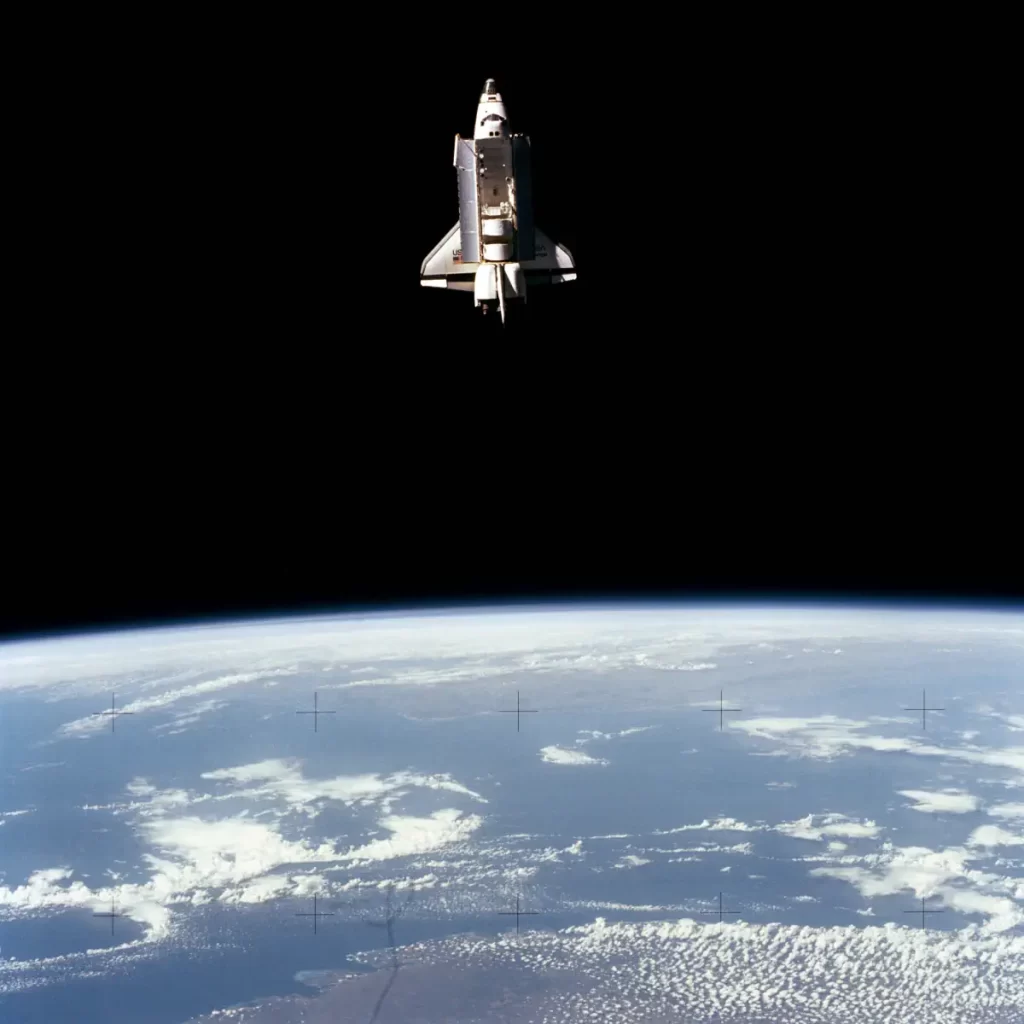
Additionally, the crew launched two commercial communications satellites, Anik C3 for Canada’s Telesat and Palapa B2 for Indonesia.
STS-7 also carried seven Getaway Special (GAS) canisters, which contained a wide variety of experiments, as well as the OSTA-2 payload, a joint U.S.-West Germany scientific pallet payload. Finally, the orbiter’s Ku-band antenna was able to relay data through the U.S. tracking and data relay satellite (TDRS) to a ground terminal for the first time.
Although originally planned to conduct the first shuttle landing at Kennedy Space Center, inclement weather in Florida forced a diversion to Edwards Air Force Base in California. Touchdown occurred on June 24.
The later career of Sally Ride
Following that historic flight, Sally Ride returned to space on another shuttle mission, STS-41G in 1984. The 8-day mission deployed the Earth Radiation Budget Satellite, conducted scientific observations of Earth, and demonstrated potential satellite refueling techniques.
She was assigned to a third flight but transitioned to a role on the Rogers Commission that investigated the Challenger disaster after that shuttle was lost on January 28, 1986. When the investigation was completed, she accepted a job as a special assistant to the NASA administrator for long-range and strategic planning.
Sally Ride left NASA in 1989 to join the faculty at the University of California, San Diego, as a professor of physics and director of the University of California’s California Space Institute.
In 2001, she founded her own company, Sally Ride Science, to pursue her long-time passion of motivating girls and young women to pursue careers in science, math, and technology.
In 2003, Ride served on the Columbia Accident Investigation Board and was the only person to serve on both the panel that investigated the Challenger disaster and the one that investigated the Columbia disaster.
Until her death on July 23, 2012, Sally Ride continued to help students – especially girls -study science and mathematics. She wrote science books and other things for students and teachers. She also worked with science programs and festivals around the United States.
Sally Ride received numerous honors and awards during the course of her career. Most notably, she was inducted into the National Women’s Hall of Fame and the Astronaut Hall of Fame in 2003, and received the Jefferson Award for Public Service, the von Braun Award, the Lindbergh Eagle, and the NCAA’s Theodore Roosevelt Award.

Sources
- Sally Ride on Wikipedia
- “Sally Ride – First American Woman in Space” on the NASA website
- “Dr. Sally Ride” on the NASA Starchild website
- Who Was Sally Ride? on the NASA website
- STS-7 on Wikipedia
- “This Week in NASA History: Sally Ride Becomes First American Woman in Space — June 18, 1983” on the NASA website
- “Sally Ride (1951-2012): NASA Astronaut / First American Woman in Space” on the NASA Solar System Exploration website
- “Sally Ride Remembered as an Inspiration to Others” on the NASA website
- Moon Landings: All-Time List [1966-2025] - February 2, 2025
- What Is Max-Q and Why Is It Important During Rocket Launches? - January 16, 2025
- Top 10 Tallest Rockets Ever Launched [2025 Update] - January 16, 2025
